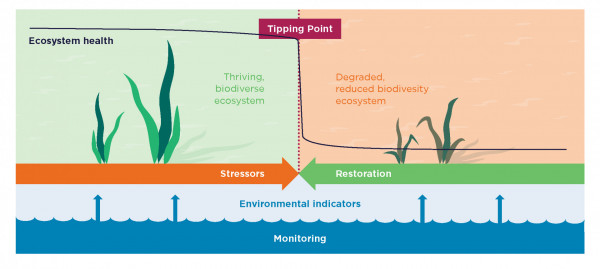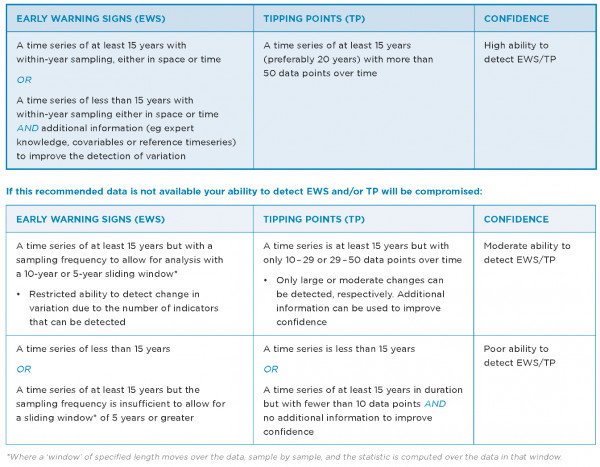- Guidance
Monitoring for tipping points in the marine environment
This guidance summarises the critical factors to consider, and the recommended data required, for a robust monitoring programme.
Stressors caused by human and natural activities can lead to a ‘tipping point’, where an ecosystem loses its capacity to cope with change and it rapidly transforms.

Tipping points are difficult to predict and often result in the loss of valuable marine resources or ecosystem services.
Interactions between multiple stressors can lead to a loss of ecosystem resilience and an increased risk of crossing a TP.
The need for environmental monitoring
Environmental monitoring is critical to detect changes so that we know the early warning signs (EWS) of when a tipping point (TP) is being approached, and to increase the certainty that a TP has occurred.
- Small-scale fluctuations in the ecosystem over time and space are EWS.
- Medium- to long-term changes over time can confirm that a TP has occurred.
Early warning signs
EWS that may indicate an upcoming TP include ecosystem indicators that:
- Have slowing rates of recovery in the ecosystem, either directly measured (diagram a) or indicated by a change in variance*, eg large variance suddenly gets smaller (diagram b) or a small variance suddenly get larger (diagram c).
- Are ‘flickering’ between alternate states causing increasing variance (diagram d).
* Variance is a statistical term that measures how far a set of numbers are spread out from their average value.
The design of monitoring programmes must be sufficiently robust to differentiate EWS and TP from natural cycles that may have an impact on marine ecosystems eg El Niño/El Niña climate cycles.
Considerations when designing monitoring programmes
- Length of time series: A time series of at least 15 years is necessary to take into account natural cyclic patterns eg global climate cycles.
- Frequency of sampling (for EWS) and number of data points (for TP): Time series with greater than 50 data points are ideal to detect a TP; within-year sampling is preferred to detect EWS.
- Expert ecological knowledge: Using existing ecological or local knowledge of what is expected to happen can increase your ability to detect change.
- Covariables: Measuring additional variables that might also cause change or confound variations over time, eg climatic indices, can also be included in your analysis.
- Reference time series: You can increase confidence in your ability to detect EWS and TP by comparing findings with other, longer ‘reference’ time series.
Recommendations for robust monitoring programmes

These recommendations and considerations can apply to any marine environment.
What is required to implement these recommendations in New Zealand?
A review of New Zealand's marine monitoring programmes in 2018 found that few of them were fit for detecting tipping points or their early warning signals.
A focus on responses, not stressors – When monitoring and managing for a tipping point it is important to consider how the ecosystem is connected, focusing not just on stressors, but on the networks of ecological responses and relationships. These can act as EWS and may allow for successful remedial action.
Integration of expert ecological knowledge in monitoring design and analysis – Using expert ecological knowledge in the design and analysis of time-series monitoring programmes for tipping points is essential where only short-term or infrequent datasets are available. This can increase the certainty that a TP has occurred and is particularly relevant in New Zealand where within-year sampling in marine monitoring programmes is limited.
An increase sampling frequency where needed – The sampling duration and frequency of many New Zealand marine monitoring programmes are currently inadequate to detect EWS/TP. Where there are numerous monitoring sites, resource limitations limit the ability to perform within-year sampling across all sites. Where possible, within-year sampling should be performed in at least a proportion of sites to enhance the ability to detect EWS/TP.
Journal reference: Hewitt JE, Thrush SF. Monitoring for tipping points in the marine environment. J Environ Manage. 2019;234:131–137
